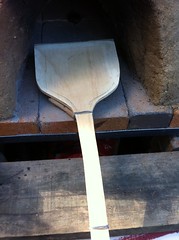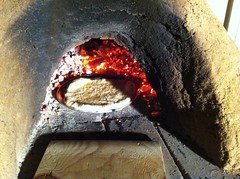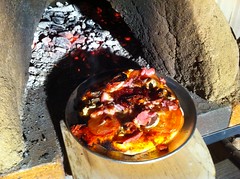 |
| Homemade Pizza Peel |
(My enthusiasm had waned due to mixed performance with bread and large cracks.)
I started the day with another trip to the Dump Shop for materials. This time to make a pizza peel (or shovel). I found a perfect piece of laminated timber, cut it to shape, and added a eucalyptus stick for a rustic handle. I used a hand sander to thin out the front edge into a blunt blade. The peel performed well, but needs some more work to thin out the 'blade'.
 |
| Patching the Crack |
While the oven was heating I patched up the cracks using some clay and sand (probably 50:50) that I had left handy in a bucket. At full heat the clay dried and blended in. It is now as if there had never been a huge gaping crack. (I know, I exaggerate.)
At 5:30 I made the pizza dough, using the recipe in an early edition of Simply No Knead Breadmaking by Carol and Ken Bates - a practical, classic Australian home bakers' 'how to'. This dough is only slightly moist and very easy to handle.
 |
| The Very First Pizza - Garlic |
- Garlic pizzas on 9-inch aluminium pizza trays on the floor.
- Pizzas with few toppings on 9-inch aluminium pizza trays.
- Pizzas with few toppings on 9-inch aluminium pizza trays on a bed of hot coals.
- Pizzas with lots of toppings on 9-inch aluminium pizza trays on hot coals.
- Garlic pizza directly on the brick floor.
- Pizza with lots of toppings directly on the brick floor.
 |
| One With The Lot |
...Geoff the L-plater oven chef
 |
| Cooking on the Bricks |
Excellent dear. I like your style...have a good one!/great blog! keep up the good work. Glad to see sites like this. Pizza Equipment
ReplyDeleteI've just started experimenting with heat and my first pizza's have been a disaster. My oven internal is about 75cm, so not too big. The problem I'm having is getting the oven hot enough and also finding the space to put the pizza. I've tried with just wood and cooking with flames, I've found you need a lot of timber to keep this going for hours. I've also mixed wood with coals. Hottest I've had is 300c, the problem I have is space in the oven. Any advice?
ReplyDeleteWow, missed this one Ollie. I assume you are past this problem by now. My technique is to use very dense wood, to fire the oven for about 3 hours, to let it 'settle' down to coals for the last 45 minutes, and then to cook on a 1 inch bed of coals, leaving the pizzas on the pizza trays. Hope this helps.
ReplyDelete...Geoff